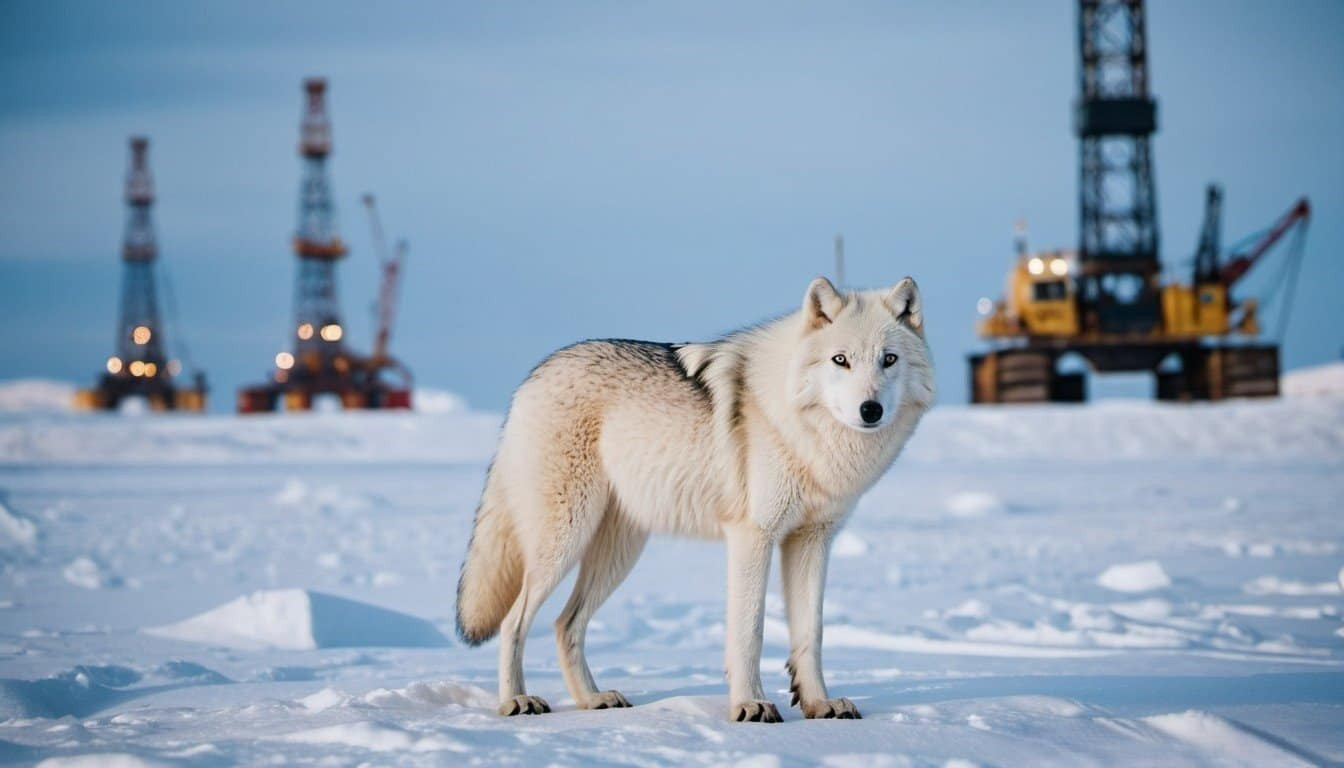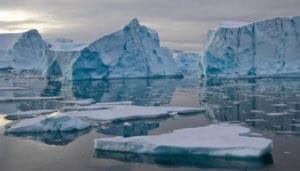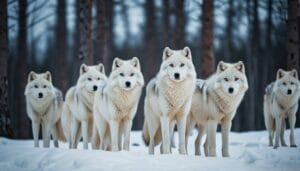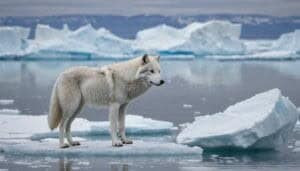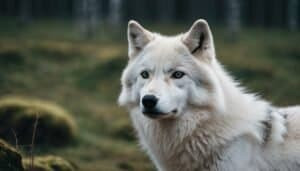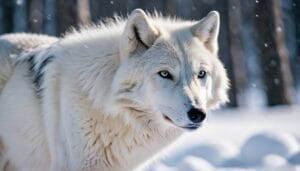Introduction
Oil and gas exploration activities in the Arctic have significant effects on the region’s wildlife, including the Arctic wolf. This article explores the main habitats of Arctic wolves and examines how environmental changes due to oil and gas exploration impact these majestic creatures
We will delve into the direct effects on the wolves, including noise pollution, habitat fragmentation, and adaptation challenges. Additionally, we will discuss conservation efforts aimed at protecting Arctic wolves and how climate change interacts with exploration activities
Understanding these impacts is crucial for the development of strategies to mitigate the negative effects on Arctic wolves and their environment
Main Habitats of Arctic Wolves
Arctic wolves, also known as polar wolves or white wolves, primarily inhabit the Arctic regions of North America and Greenland
These areas are characterized by extremely cold temperatures, ice-covered landscapes, and minimal vegetation. The primary habitats of Arctic wolves include tundra regions, boreal forests, and coastal areas
Tundra Regions
Tundra regions, with their vast open spaces and sparse vegetation, provide a challenging but suitable environment for Arctic wolves. These regions offer vast hunting grounds for prey such as Arctic hares, musk oxen, and caribou
The open landscape allows wolves to travel and hunt efficiently, while the cold climate helps them maintain their thick fur coats
Boreal Forests
Boreal forests, also known as taiga, are another crucial habitat for Arctic wolves. These forests provide shelter from the harsh Arctic winds and serve as breeding grounds
The dense vegetation offers cover for wolves to raise their pups and hide from potential threats. The prey availability in boreal forests, including moose and other ungulates, supports the dietary needs of Arctic wolves
Coastal Areas
Coastal areas, particularly those near the Arctic Ocean, are vital for Arctic wolves. These regions often have higher prey densities, such as seals and seabirds, which are essential for the wolves’ diet, especially during the harsh winter months
The proximity to the ocean also means that coastal areas are more prone to the impacts of oil and gas exploration, making these habitats particularly vulnerable
Environmental Impacts of Oil and Gas Exploration
Oil and gas exploration in the Arctic has far-reaching environmental impacts that affect not only the landscape but also the delicate ecosystems that support Arctic wolves. These impacts range from physical changes in the environment to chemical pollution and long-term ecological shifts
Effects on the Arctic Environment
Oil and gas exploration activities disrupt the pristine Arctic environment in multiple ways. The construction of drilling sites, pipelines, and roads leads to the destruction of natural habitats and alters the landscape
This infrastructure development often results in soil erosion, changes in water drainage patterns, and permafrost thawing
One of the most significant environmental concerns is the risk of oil spills, which can devastate the fragile Arctic ecosystem. Oil spills can contaminate water sources, soil, and vegetation, making it difficult for wildlife to find clean food and water
Additionally, the clean-up process for oil spills in the Arctic is challenging due to the harsh weather conditions and remote locations, often leading to prolonged environmental damage
Oil Spillage and the Arctic Ecosystem
Oil spills are among the most catastrophic events for the Arctic ecosystem. When oil is released into the environment, it can spread quickly across ice and water surfaces, covering vast areas and impacting numerous species
For Arctic wolves, oil contamination can lead to a reduction in prey availability, as many of their food sources, such as fish and seabirds, are affected by the spill
Furthermore, direct contact with oil can be harmful to Arctic wolves. Oil can coat their fur, reducing its insulating properties and making them more susceptible to the cold. Ingesting oil while grooming can also lead to poisoning and other health issues
The long-term effects of oil spills can include genetic mutations, reproductive issues, and a decrease in overall population health
Long-term Effects of Gas Flaring
Gas flaring, the process of burning off excess natural gas during oil extraction, has significant long-term effects on the Arctic environment. This practice releases a variety of pollutants, including carbon dioxide, methane, and black carbon, which contribute to global warming and climate change
The increase in greenhouse gases from gas flaring accelerates the melting of Arctic ice, further disrupting the habitat of Arctic wolves and other wildlife. Additionally, the pollutants released can settle on ice and snow, reducing their reflectivity and causing them to absorb more heat
This process, known as the albedo effect, exacerbates the warming of the region
Direct Impacts on Arctic Wolves
Oil and gas exploration in the Arctic directly affects Arctic wolves in numerous ways. These impacts range from physical disruptions to their environment to changes in their behavior and overall health
Understanding these direct impacts is crucial for developing effective conservation strategies
Noise Pollution and Arctic Wolves
Noise pollution from oil and gas exploration activities can significantly disrupt the behavior and communication of Arctic wolves. The constant noise from drilling, machinery, and transportation can interfere with the wolves’ ability to communicate with each other, which is vital for hunting and social interactions
Loud noises can also cause stress and anxiety, leading to changes in behavior such as increased aggression or avoidance of certain areas
Additionally, noise pollution can impact the prey species that Arctic wolves rely on for food. Animals like caribou and hares may alter their movement patterns to avoid noisy areas, making it harder for wolves to find and hunt them
This disruption in the food chain can lead to nutritional stress for Arctic wolves, affecting their health and reproductive success
Habitat Fragmentation
The construction of infrastructure for oil and gas exploration leads to habitat fragmentation, which can have severe consequences for Arctic wolves
Roads, pipelines, and drilling sites can divide the landscape into smaller, isolated patches, making it difficult for wolves to travel, hunt, and find mates. This fragmentation can lead to a decrease in genetic diversity as isolated populations are unable to interbreed
Habitat fragmentation also reduces the availability of suitable denning sites for Arctic wolves. These sites are essential for raising pups and providing shelter from harsh weather conditions. When these areas are disturbed or destroyed, it can lead to lower pup survival rates and decreased population growth
Adaptation to Environmental Changes
Arctic wolves have evolved to survive in some of the harshest conditions on Earth, but the rapid environmental changes caused by oil and gas exploration present new challenges
The loss of ice and snow cover due to climate change and exploration activities alters the hunting and traveling patterns of Arctic wolves. They must adapt to these changes by altering their diet, hunting strategies, and movement patterns
In some cases, Arctic wolves may venture closer to human settlements in search of food, increasing the risk of human-wolf conflicts. These encounters can be dangerous for both wolves and humans, leading to potential harm or death for the animals
Adaptation to environmental changes is a continuous process, but the rapid pace of oil and gas exploration exacerbates the difficulties Arctic wolves face in maintaining their traditional way of life
Conservation Efforts
Efforts to conserve Arctic wolves and mitigate the impacts of oil and gas exploration are crucial for ensuring the survival of this species. Various strategies, including legal protections, habitat restoration, and international cooperation, are being implemented to protect Arctic wolves and their environment
Protecting Arctic Wolves
Several legal protections are in place to safeguard Arctic wolves from the detrimental effects of oil and gas exploration. National and international laws regulate the activities of oil and gas companies in the Arctic, ensuring that they adhere to environmental standards that minimize harm to wildlife
For example, the Endangered Species Act in the United States provides protections for species at risk, including the Arctic wolf
Protected areas and wildlife reserves are also established to provide safe habitats for Arctic wolves. These areas restrict or prohibit oil and gas exploration activities, preserving critical habitats and reducing the risk of habitat fragmentation and pollution
Conservation organizations work closely with governments to designate and manage these protected areas effectively
Interaction Between Climate Change and Oil Exploration
Climate change and oil exploration are interconnected threats that compound the challenges faced by Arctic wolves. The melting of Arctic ice due to global warming opens up previously inaccessible areas for oil and gas exploration, increasing the potential for habitat disruption
Additionally, the pollutants released from exploration activities contribute to further climate change, creating a vicious cycle of environmental degradation
Efforts to address climate change are crucial for the long-term conservation of Arctic wolves. Reducing greenhouse gas emissions, transitioning to renewable energy sources, and implementing carbon capture technologies can help mitigate the effects of climate change on the Arctic ecosystem
International agreements, such as the Paris Agreement, play a vital role in coordinating global efforts to combat climate change and protect Arctic habitats
International Cooperation
The conservation of Arctic wolves requires collaboration among countries with interests in the Arctic region
International cooperation is essential for sharing knowledge, resources, and strategies to address the impacts of oil and gas exploration. Organizations such as the Arctic Council facilitate dialogue and cooperation among Arctic nations, focusing on sustainable development and environmental protection
Cross-border conservation initiatives aim to create contiguous protected areas that span multiple countries, ensuring that Arctic wolves can move freely across their natural range without encountering habitat fragmentation
These initiatives also promote the sharing of best practices and technologies for minimizing the environmental footprint of oil and gas exploration
Community Engagement
Engaging local communities in conservation efforts is vital for the success of initiatives to protect Arctic wolves. Indigenous peoples and local residents often have valuable traditional knowledge and a deep connection to the land, making them essential partners in conservation
Community-led monitoring programs, where locals track the health and movements of Arctic wolves, provide valuable data that can inform conservation strategies
Educational programs and awareness campaigns also play a crucial role in fostering a culture of conservation. By educating the public about the importance of Arctic wolves and the threats they face, conservation organizations can build support for protective measures and encourage sustainable practices that benefit the entire ecosystem
Conclusion
The Arctic wolf, a majestic and resilient species, faces significant challenges due to oil and gas exploration in its habitat. This exploration disrupts the main habitats of Arctic wolves, such as tundra regions, boreal forests, and coastal areas, altering their environment and threatening their survival
Environmental impacts of oil and gas exploration, including habitat destruction, oil spills, and long-term effects of gas flaring, create a hostile environment for Arctic wolves. These activities not only contaminate their habitat but also affect the availability of prey and the overall health of the ecosystem
Direct impacts on Arctic wolves, such as noise pollution, habitat fragmentation, and the need to adapt to rapid environmental changes, further complicate their existence. The disruption of communication, increased stress levels, and loss of genetic diversity are among the critical issues Arctic wolves face due to exploration activities
Conservation efforts are essential to mitigate these impacts and ensure the survival of Arctic wolves. Legal protections, the establishment of protected areas, international cooperation, and community engagement are vital components of these efforts
Addressing the intertwined threats of climate change and oil exploration through global initiatives and sustainable practices is crucial for preserving the delicate Arctic ecosystem
By understanding the profound effects of oil and gas exploration on Arctic wolves and implementing comprehensive conservation strategies, we can work towards a future where these magnificent animals continue to thrive in their natural habitat
